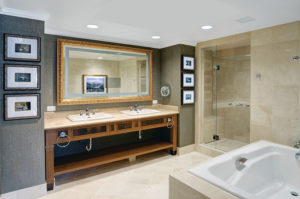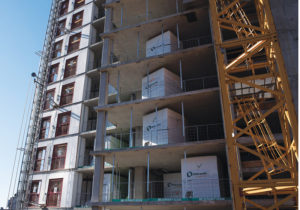For hotel owners, a big concern when it comes to design and construction is the time it takes to complete a project. Hoteliers want things to get done quickly and efficiently—after all, the sooner a property comes online, the sooner the hotel can start making money and serving guests—but quality is also key. That’s why many hotels are turning to prefabricated designs for reoccurring elements like the bathroom.
Bill Seery, director of business development for Oldcastle SurePods, explained that his company launched in 2005 because it saw an opportunity in the modular space. “We are emulating what happened from a demographic crunch in Europe and Asia years ago. We looked at that and thought, ‘What will happen in the States?’” questioned Seery. The crunch he’s referring to relates to the fact that as construction workers and tradespeople retire, they’re not necessarily being replaced, as other methods of building—like modular construction done in factories—are on the rise.
“It’s forcing construction to move offsite and use manufacturing strategies. The labor crisis is in full bloom and we are really seeing rapid adoption of all sorts of modular strategies,” added Seery.
Oldcastle refers to itself as “component modular.” What does that mean? Just as companies like Otis have the elevator component, this central Florida company has the means to build the bathroom components on a large scale. “We have been building these pods for the last 12 years and we have built bathrooms for 20,000 hotel rooms,” said Seery.
According to the executive, there are many benefits to modular construction, including speed, simplicity, safety and superior quality—or the Four S’s, as Oldcastle calls them.
The average bathroom can take 110 hours on average to build, according to Seery. Oldcastle’s modular bathrooms are all built in-house at its factory, then shipped to the construction site where they’re installed in 10 minutes. This, he said, can assist a hotel in opening early—thus alleviating labor and construction costs for hotels, and moving up the property’s ramp-up period. Seery saw this with one of the company’s major projects, the 400-room Residence Inn/Courtyard at L.A. Live, which opened two months early. “That’s money in the owner’s pocket. It gets them to the ‘heads in the bed’ phase earlier,” he said.
With regard to safety, Seery said there’s less of a risk profile because subcontractors are not being managed—and the project is not experiencing the wrath of nature’s elements.
And, finally, Seery believes that superior quality is what sets modular, prefabricated bathrooms apart. “We have turned bathroom production into the equivalent of a car production factory. You’re getting Mercedes quality in a bathroom—and it’s repeatable quality,” Seery said. Still, Oldcastle offers extended warranties on items in its bathroom from the no-crack, no-stain ceiling, to the structure. “We build our bathrooms so rugged because they should be able to survive transportation to the job site. They are the strongest element in the building—so you get a great warranty,” explained Seery.
For its part, Oldcastle builds its bathrooms in Orlando—where there is affordable labor—and then ships the product to more expensive markets, such as New York, California, the Pacific Northwest and New England. “We make more sense in these places than we do in lower-cost markets,” said Seery, who noted select-service properties in the IHG, Hilton, Marriott and Hyatt brands seem to be using the modular style.
“It also works great with four- or five-star properties, but sometimes those get very large. We are not the answer to every problem right now—but the classic, urban style—that’s where we are,” maintained Seery. “If you’re going vertical, you’re going to see some solid RevPAR numbers after you open the hotel and that’s a really good match for us.”
Oldcastle has completed bathrooms in properties such as The Broadmoor in Colorado Springs, CO; an Embassy Suites by Hilton in Seattle; and the upcoming InterContinental Los Angeles Downtown. “We have built everywhere from downtown New York to out in the prairie in West Texas,” said Seery.
Typically, there are three styles of bathroom in every hotel: the tub style, the shower style and an alternate. Oldcastle is accustomed to manufacturing these three styles, but can do more styles as well for a project. “We are looking for some level of standardization of bathroom design types, but we have never done a hotel where there is just one type,” said Seery. “Now, if it’s a boutique hotel with a different layout and different bathrooms in each room—that would be better built in the traditional way by tradespeople because that’s really down to the craftsman level.” He noted that modular isn’t the solution all of the time but “80% of the time—we are.”
So what should hoteliers ask themselves to determine if modular is the right fit for a project? The most important question is this: Is it early in the design cycle for the hotel? If so, and if the location makes sense, modular bathrooms may be the way to go. “The earlier in the decision-making process, the more benefit can come from it. Once you’re down the road and getting into that late-stage construction, the contractor is already in discussions with local subcontractors. At that point, you’re not going to get the toothpaste back in the tube,” said Seery. Also, if a hotel builder is building properties rapidly and is unhappy with the status quo—modular bathrooms may be their solution.
According to the executive, modular is a growing trend with no signs of slowing down—particularly when it comes to bathrooms. In a hotel room, one can switch out the bed, the desk and other furniture with ease—but not the bathroom. “The only thing in the room that’s permanent is the bathroom, and that’s what we are focusing on in this industry,” he said. “Because of this, I view modular bathrooms as a continuing trend that will trickle into consciousness in the future… This is an exciting time in hospitality development. We are really coming back strong from the recession. We are hoping to serve this market for a long time.” HB



